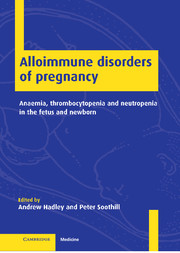 Alloimmune Disorders of Pregnancy
Alloimmune Disorders of Pregnancy Book contents
- Frontmatter
- Contents
- List of contributors
- Preface
- Foreword
- List of abbreviations
- 1 Pathophysiology of the alloimmune cytopenias
- 2 Blood group antibodies in haemolytic disease of the fetus and newborn
- 3 Basis and practice of screening for haemolytic disease of the fetus and newborn
- 4 Epidemiology and screening for alloimmune thrombocytopenia
- 5 Principles of antibody-mediated immune suppression and the prevention of maternal RhD alloimmunization
- 6 The clinical application of anti-D prophylaxis
- 7 Fetal genotyping
- 8 Laboratory assays to determine the severity of haemolytic disease of the fetus and newborn
- 9 Assessing the severity of haemolytic disease of the fetus and newborn: clinical aspects
- 10 Antenatal therapy for haemolytic disease of the fetus and newborn
- 11 Neonatal therapy for haemolytic disease of the newborn
- 12 The diagnosis of alloimmune thrombocytopenia
- 13 The immunological diagnosis of alloimmune neutropenia
- 14 Fetal and neonatal treatment of alloimmune thrombocytopenia
- Index
Preface
Published online by Cambridge University Press: 26 October 2009
- Frontmatter
- Contents
- List of contributors
- Preface
- Foreword
- List of abbreviations
- 1 Pathophysiology of the alloimmune cytopenias
- 2 Blood group antibodies in haemolytic disease of the fetus and newborn
- 3 Basis and practice of screening for haemolytic disease of the fetus and newborn
- 4 Epidemiology and screening for alloimmune thrombocytopenia
- 5 Principles of antibody-mediated immune suppression and the prevention of maternal RhD alloimmunization
- 6 The clinical application of anti-D prophylaxis
- 7 Fetal genotyping
- 8 Laboratory assays to determine the severity of haemolytic disease of the fetus and newborn
- 9 Assessing the severity of haemolytic disease of the fetus and newborn: clinical aspects
- 10 Antenatal therapy for haemolytic disease of the fetus and newborn
- 11 Neonatal therapy for haemolytic disease of the newborn
- 12 The diagnosis of alloimmune thrombocytopenia
- 13 The immunological diagnosis of alloimmune neutropenia
- 14 Fetal and neonatal treatment of alloimmune thrombocytopenia
- Index
Summary
Definitions and terminology
The alloimmune cytopenias are a group of conditions in which the life span of fetal blood cells or their precursors is shortened by the action of antibodies derived from the mother by placental transfer. Three conditions are recognized: antibodies to fetal red cells, platelets or neutrophils, or their precursors, cause alloimmune anaemia, thrombocytopenia or neutropenia, respectively. Various terms are in common usage for these disorders, many of them inappropriate. For example, alloimmune anaemia is sometimes referred to as Rhesus disease, erythroblastosis fetalis or haemolytic disease of the newborn and all three are misnomers. It is incorrect to use ‘Rhesus’ to refer to the Rh system, fetal haemolysis may be caused by antibodies outside the Rh system, anaemia is not always associated with erythroblastosis and, finally, the disorder primarily affects the fetus rather than the newborn. Therefore, throughout this book, alloimmune anaemia (perhaps the best term) will be referred to as haemolytic disease of the fetus and newborn (HDFN). For similar reasons, alloimmune thrombocytopenia and alloimmune neutropenia will be used in preference to other terms, such as neonatal alloimmune thrombocytopenia, fetomaternal alloimmune thrombocytopenia and neonatal alloimmune neutropenia, while, at the same time, acknowledging that these terms are also commonly used.
- Type
- Chapter
- Information
- Alloimmune Disorders of PregnancyAnaemia, Thrombocytopenia and Neutropenia in the Fetus and Newborn, pp. xvii - xviiiPublisher: Cambridge University PressPrint publication year: 2001
